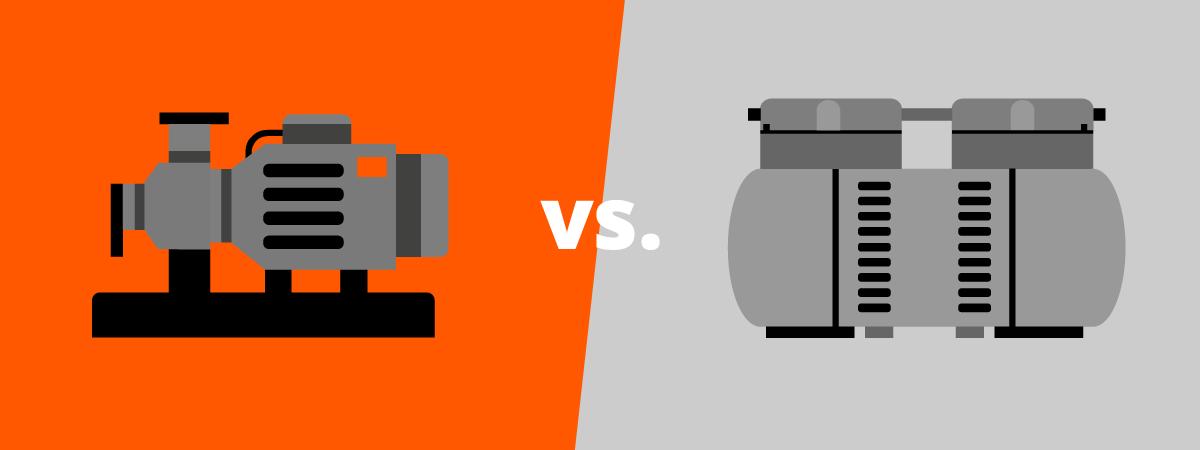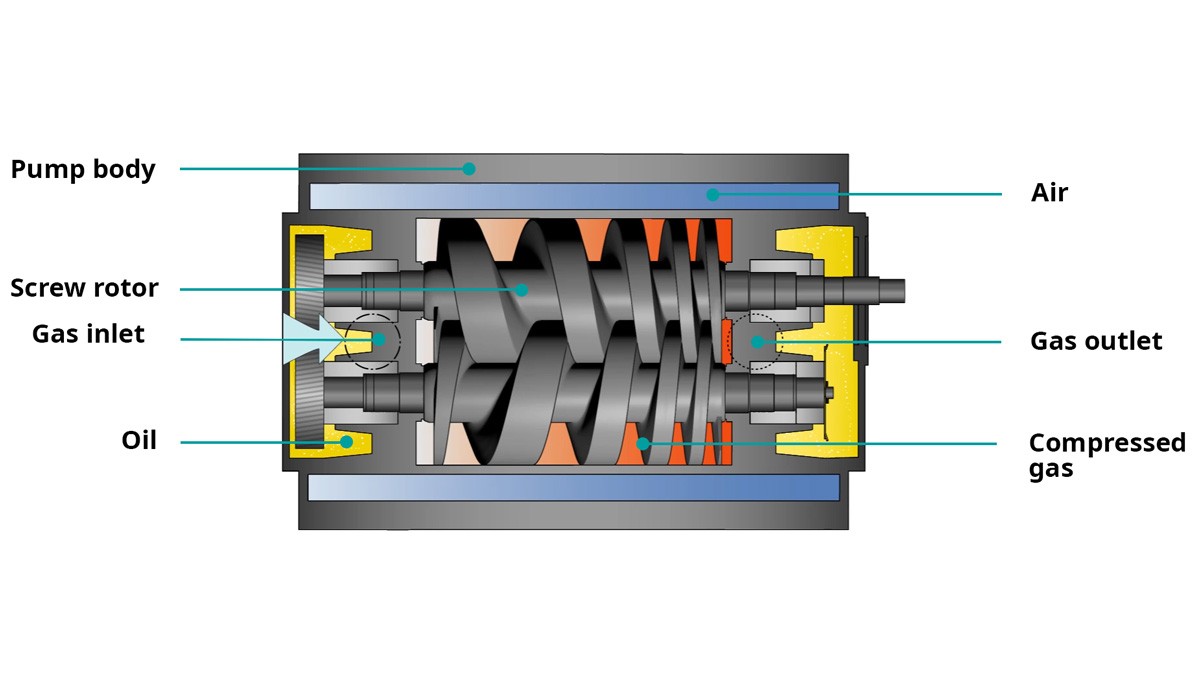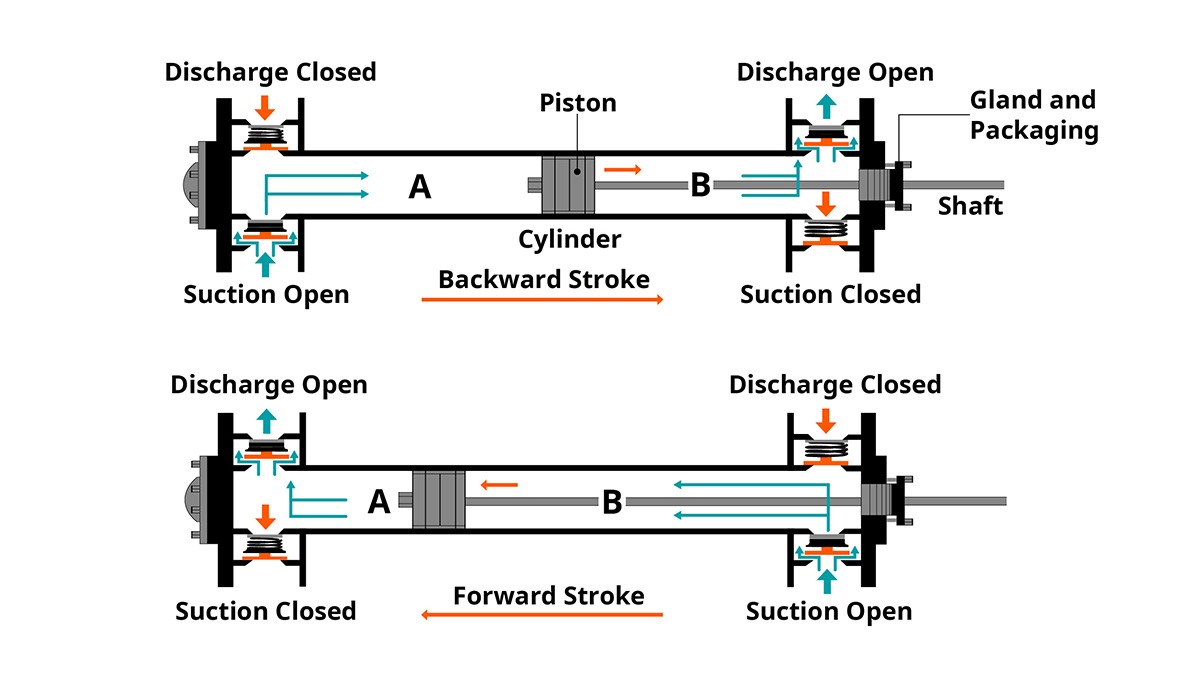Piston Pumps vs. Screw Vacuum Pumps
Explore the differences between piston pumps and screw vacuum pumps, and discover why screw vacuum pumps are often the better choice for optimal vacuum performance in your application.
Piston pumps and
screw vacuum pumps are two common types of pumps used to generate the required vacuum in industrial, commercial, and laboratory settings. While both have their advantages, screw vacuum pumps provide superior performance in many applications, from packaging to growing silicon crystals for solar panels. Choosing the right vacuum technology is crucial for operational efficiency and cost-effectiveness.
How screw vacuum pumps work
A
screw vacuum pump is a positive displacement pump that removes air or other gases from a sealed environment to generate vacuum. It operates using two screw rotors that rotate in opposite directions within a cylindrical housing. The pumped medium enters the vacuum pump through the inlet and is trapped in chambers formed between the cylinder and the twin screws. As the rotors turn, they move the pumped medium along the length of the screws towards the outlet. During this process, the space (volume) available for the pumped medium is reduced because the chamber size continuously decreases. As a result, the pumped medium is compressed until it reaches its smallest possible volume. It is then expelled through the outlet.
During the process, the screw rotors do not come into contact with each other or the housing of the pump, which minimizes wear and eliminates the need for lubricants like oil.
How piston pumps work
Just like screw vacuum pumps, piston pumps operate on the principle of positive displacement. They were initially designed for the efficient transfer of water and other fluids under pressure, primarily for agricultural and domestic use in drawing water from wells or rivers. They are, however, also able to generate vacuum.
The pump itself consists of a cylinder in which a piston moves back and forth. On each side of the cylinder, a valve – one for suction, one for discharge – is positioned. The piston is linked to a connecting rod that is attached to a crankshaft. Powered by an electrical motor, the crankshaft rotates, moving the piston when the pump is running.
Vacuum generation begins with the intake stroke, where the piston moves backwards. This increases the volume in the cylinder. As the volume increases, the pressure inside the cylinder is reduced and the gas molecules have more space to move around. The pressure inside the cylinder is now lower than that of the vessel to be evacuated. As gases move from areas of higher pressure to areas of lower pressure, the air or gas in the vessel is suctioned into the cylinder.
Once the piston reaches the end of its stroke, the suction valve closes, trapping the pumped medium inside. The piston then moves in the opposite direction, decreasing the cylinder volume and compressing the pumped medium. As it is compressed, its pressure increases, and it is expelled through the discharge valve. By repeatedly moving the piston back and forth, the pump continuously evacuates air or gas from the vessel, generating vacuum.
Types of piston pumps
In contrast to vacuum pumps, piston pumps are not optimized for generating constantly high vacuum levels but can be effective for rough to medium vacuum. To achieve a more consistent flow, pumps with multiple pistons and cylinders can be utilized. Single-acting piston pumps have one valve on each end, where gas suction and discharge take place following the principle described above. Each cycle of the piston generates vacuum by suctioning gas during the intake stroke, followed by compression and discharge during the exhaust stroke.
In contrast, double-acting piston pumps generate vacuum during both the backward and the forward stroke of the piston. In this design, the cylinder is divided into two chambers, one on either side of the piston. Each chamber has a suction and a discharge valve.
As the piston moves backwards, the volume in chamber A expands. Simultaneously, the chamber pressure decreases, suctioning gases from the pumped container through the suction valve. In chamber B, the process happens in reverse. So, with the backward stroke of the piston, previously pumped gas is compressed and expelled through the discharge valve. When the piston moves forward again, the roles of the chambers switch. This means that the suctioning of gas takes place in chamber B, while the pumped gas in chamber A is compressed and discharged. This design is more efficient since evacuation takes place on both the backward and the forward strokes, resulting in a steadier flow.
Typical applications
While
screw vacuum pump and piston pumps differ in their operating principle, they can be used in many of the same applications. However, piston pumps cannot attain high vacuum levels. They are capable of operating in rugged environments with fluctuating temperatures, as well as abrasive substances like sand which might be present in the pumped medium. Relevant applications are, for example, heat treatment in composite manufacturing, vacuum distillation in chemical and pharmaceutical industries, or vacuum melting in metallurgy.
Screw vacuum pumps can be used just as effectively in the same demanding applications as piston pumps but offer additional benefits. They can reach higher vacuum levels, require less maintenance, and operate more cleanly. Therefore, they are also suitable for
steel degassing,
freeze-drying processes in the food industry, or various applications in
lithium battery manufacturing, for example. They are available in different designs, offering options to adapt them to different industries – also those that require clean, contamination-free environments like
semiconductor manufacturing.
Advantages of screw vacuum pumps
Energy efficiency
Screw vacuum pumps are more energy efficient in vacuum applications, where piston pumps tend to struggle. Piston pumps, originally designed to move fluids in a high-pressure range, can waste energy when generating vacuum. This is due to the mechanical movement of the piston that is needed to maintain vacuum, along with friction and heat loss. Therefore, piston pumps are often used in intermittent operation. This means that they are turned on and off at intervals, for example in packaging or handling and lifting, where vacuum is only needed for short periods. In contrast, screw vacuum pumps generate vacuum through rotation, which allows more efficient continuous operation. This minimizes energy losses and helps to maintain constant vacuum levels.
Vacuum pumps from Busch are designed to maximize energy efficiency. They can be equipped with
ECOTORQUE, the variable speed drive (VSD) from Busch. This option is also available for
COBRA dry screw vacuum pumps. By adjusting the rotational speed of the vacuum pump to match the actual process requirements,
ECOTORQUE can achieve energy savings of up to 50%. This makes the feature an ideal choice for all industries that want to reduce energy costs and improve operational efficiency.
Maintenance
Screw vacuum pumps generally require less maintenance compared to piston pumps. Piston pumps have more mechanical components, such as cylinder liners and bearings, that experience wear over time. Screw vacuum pumps offer better long-term durability, particularly in applications where the pump is in continuous use, and where downtime due to maintenance must be kept to a minimum. The screw rotors inside the vacuum pump do not come in contact with each other or the cylinder housing. This contact-free compression of the pumped medium leads to no wear on the moving parts. For
COBRA dry screw vacuum pumps, maintenance costs are kept at a minimum since only the gear oil has to be changed at regular intervals.
Operating costs
Piston pumps require a constant oil supply to ensure proper lubrication of moving parts, maintain a tight seal between pistons and cylinder walls, and dissipate heat generated during operation. For this reason, many customers install a special oil line to eliminate the need for constant refilling. However, this leads to higher operating costs due to the large amounts of oil consumed.
COBRA dry screw vacuum pumps from Busch do not need oil in the compression chamber, saving these expenses.
Noise levels
The back-and-forth motion of piston pumps tends to generate significant noise and vibration levels. This can be a problem in environments where noise control and minimal vibration are important.
COBRA dry screw vacuum pumps operate at a much lower noise level of about 69 dB(A), comparable to the sound of a domestic vacuum cleaner. In contrast, depending on its size, a piston vacuum pump can reach up to 85 dB(A), which is equivalent to standing near a busy road.
Operational reliability
Piston pumps are primarily used to move liquids or gases through the back-and-forth motion of a piston within a cylinder. They are not optimized for maintaining high vacuum levels in continuous operation but can be effective for generating rough to medium vacuum, such as for vacuum forming or packaging.
Screw vacuum pumps from Busch are known for their long service life, providing efficiency as well as operational reliability over extended periods for all vacuum levels.
COBRA dry screw vacuum pumps are designed for challenging environments like steel degassing. They have extremely high vapor and particle tolerance, ensuring unwavering performance in demanding industrial applications.
What are screw vacuum pumps?
Screw vacuum pumps are positive displacement pumps that employ two screw rotors rotating in opposite directions within a cylindrical housing. These rotors trap and transport the pumped medium through chambers formed between the cylinder and the screws. The medium is compressed and expelled through the outlet without the need for lubricants or operating fluids in the compression chamber, making them ideal for applications requiring clean vacuum environments.
Piston pumps are positive displacement pumps that use a reciprocating piston to move either fluids or gases through a cylinder. As the piston moves back and forth, it decreases the pressure within the chamber by increasing its volume, allowing the pump to draw in, compress, and then expel fluid or gas.
Can piston pumps be used for vacuum generation?
Yes, piston pumps can generate vacuum for certain applications. However, they are not optimized for achieving high vacuum levels since they were originally designed to move fluids. They can be effective for generating rough to medium vacuum, which is sufficient for tasks like vacuum forming.
What is the difference between a screw vacuum pump and a piston pump?
Screw vacuum pumps and piston pumps differ in both their operating principles and applications. Screw vacuum pumps generate vacuum by removing air and other gases from a sealed environment using two rotating screws. They achieve deeper vacuum levels and operate more efficiently across all vacuum ranges, making them suitable for various industrial uses. Additionally, they also provide advantages in terms of lower maintenance requirements, reduced noise levels, improved efficiency, and greater versatility.
A piston pump evacuates a sealed environment by repeatedly moving its piston back and forth. As a result of this back-and-forth motion, piston pumps require regular oil lubrication and more maintenance. Additionally, piston pumps were originally designed to handle fluids, which leads to energy inefficiencies in vacuum applications.
How do I select the appropriate vacuum technology?
Several factors have to be considered when selecting the right vacuum solution. These factors vary depending on the application and the specific needs of your process.
Use our product finder to find your ideal vacuum pump. Or contact us to find out which vacuum solution fits your needs best. Our Busch experts are happy to help!



